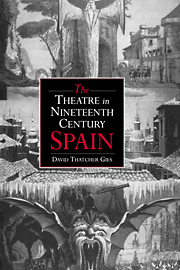Book contents
- Frontmatter
- Contents
- Preface
- Introduction: literary history and canon formation
- 1 Spanish theatre in the nineteenth century. (An overview)
- 2 Theatre and dictatorship: from Napoleon to Fernando VII
- 3 Romanticism and beyond (1834-1849)
- 4 The theatre at mid-century
- 5 “This woman is quite a man!”: women and the theatre (1838-1900)
- 6 High comedy, and low
- 7 Conflicting visions: neo-Romanticism, ridicule, and realism
- Conclusion
- Bibliography
- Index of names
- Index of plays
7 - Conflicting visions: neo-Romanticism, ridicule, and realism
Published online by Cambridge University Press: 07 May 2010
- Frontmatter
- Contents
- Preface
- Introduction: literary history and canon formation
- 1 Spanish theatre in the nineteenth century. (An overview)
- 2 Theatre and dictatorship: from Napoleon to Fernando VII
- 3 Romanticism and beyond (1834-1849)
- 4 The theatre at mid-century
- 5 “This woman is quite a man!”: women and the theatre (1838-1900)
- 6 High comedy, and low
- 7 Conflicting visions: neo-Romanticism, ridicule, and realism
- Conclusion
- Bibliography
- Index of names
- Index of plays
Summary
By 1870, notwithstanding the chaos which dominated the political panorama, Spain's theatres seemed to be healthy and thriving. According to El Entreacto of 4 March 1871, “Hay en España 335 teatros con 169.376 localidades, donde se celebra por término medio de cada año 8.000 funciones dramáticas, 1.000 de ópera y 3.000 de zarzuela” (“Spain has 335 theatres with 169,376 seats, where on average some 8,000 dramatic works, 1,000 operas, and 3,000 zarzuelas are put on each year”). Fifteen of these theatres were in Barcelona, eleven in Madrid (although Madrid had more total seats than Barcelona), four each in Cádiz and Zaragoza, three each in the Balearic Islands, Córdoba, Sevilla, and Valladolid, two each in Alicante, La Coruña, Granada, Lérida, Málaga, Salamanca, and Valencia, and one in every other provincial capital except Castellón, Logroño, and Toledo. There existed some 45 dramatic societies which promoted theatre in the provincial capitals. These statistics, if accurate, are extraordinary, for they reveal a lively interest in theatre and a significant rise in the number of playhouses from just a decade previously - 91 in capital cities (up from 74) and 244 in small towns (up from 219). Printed texts were also readily available and thereby increased public knowledge of and attention to the theatre. Several publishers dominated the industry of printing inexpensive editions of recent plays.
- Type
- Chapter
- Information
- The Theatre in Nineteenth-Century Spain , pp. 292 - 348Publisher: Cambridge University PressPrint publication year: 1994

